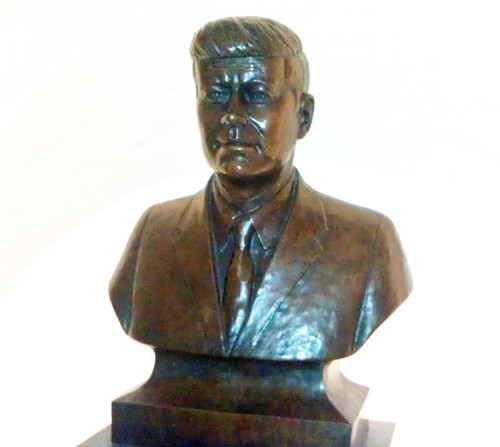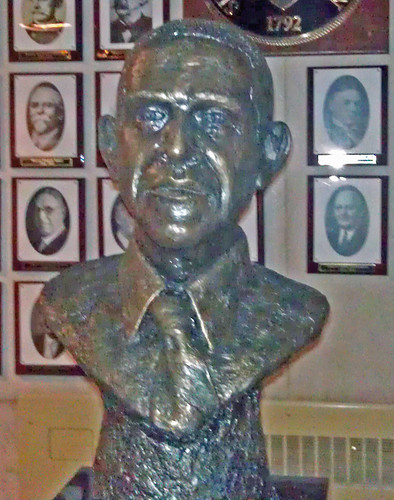Ever since word began trickling out last November that
Anthony Roberts and company had concocted a plan to place a bust of President
Obama in city hall, we’ve been questioning the process used to fund the bust
and the motives behind it.
There was already a bust of a president, John F. Kennedy, in
the city hall atrium. The bust was in city hall before the annex was built. This
made us curious about the how’s and wherefore’s and why’s of that bust.


Probably the first question to come to mind is what is the
JFK bust made of?
We weren’t sure. We thought maybe metal but then we looked
at it again and thought, “Maybe stone.” The impression of stone comes from the
softer, rounder edges of the sculpture compared to the sharper edges of the
Obama figure. Regardless, even a novice can tell just by looking that the JFK
bust has more heft. Not only is it larger in dimensions than the new arrival,
it just radiates a sense of mass, a sense of substance.
Next, we wondered how it came to be in its niche in city
hall.
That wasn’t tough. After President Kennedy was slain
memorials sprang up everywhere. Schools, airports, roads and public buildings
were named after him. Busts and portraits were installed in public edifices
everywhere.
Who paid for the bust of JFK?
Good question. Something deep down inside told us the bust
was NOT purchased by the city fathers. Surely some group came forward with the
idea of raising the money and purchasing the bust and donating it to the city.
Thanks to Wendy Nardi and the resources in the Trentoniana
Collection at the Trenton Free Public Library, here’s what we were able to
learn.
According to an article in the Trenton Evening Times, SundayOctober 3, 1965:
Apparently, Mr. Cristofaro was well known enough in the area to not have to be described any further in the article. This was proven with a little more research.
The Mercer County Barracks NO 1895, Veterans of World War I, are attempting to raise money to purchase a bronze bust of the late President John F. Kennedy.
The veterans chapter wants to donate the bust to the city for display on a granite pedestal in the entrance of the new City Hall Annex.
“Until the new building is constructed it could be displayed at the entrance of City Hall,” said Robert E. Germond, post commander.
Germond explained that the bust would cost approximately $2,300 and that his organization would need all the help it can get to purchase the memorial.
The article goes on to name members of the committee and
where contributions could be sent. There is even a commitment to donate any
monies raised in excess of the actual cost to the Kennedy Library Foundation.
Three months later, on January 5, 1966, the Times ran
another small story that fund raising was in full swing. (The article can be found as part of the same file on the link above)
Finally, on August 15, 1967, the bust of JFK was dedicated.
In an article from Sunday, August 13 of that year we learn who the artist was and
more. (Page three of the document linked above)
The artist was Anthony Cristofaro, who worked with Mayor’s Assistant Robert Carmignani and Superintendent, Division of Public Property, Joseph McManimon in selecting a permanent site.
Apparently, Mr. Cristofaro was well known enough in the area to not have to be described any further in the article. This was proven with a little more research.
Anthony M. Cristofaro was a native of Italy who came to America Trenton
Mr. Cristofaro shared his love of art and talent for
sculpting with the community. Besides is commissioned work, he taught sculptingin his studio and, free of charge, to boys at the Junior League’s InternationalInstitute.
At least some of his work was cast at the renowned Roman
Bronze Works in New York
So, what does this all mean?
- When the notion to memorialize the late President Kennedy was conceived, a plan was developed.
- A committee outside of the sphere of local government was created.
- Fund raising was conducted publicly with notices in the local press.
- A local artist was chosen to execute the work.
- The bust is cast in bronze. Really.
- The placement of the bust was worked out in coordination with the facilities people in city government.
It means things were done right; correctly; openly.
We can’t say that about the Obama bust now, can we.
And we’re not surprised.
NOTE: According to one CPI calculator we found, that $2,300 in 1965 would have the purchasing power of $16,800 today. Understandable considering the cost of bronze (which is mostly copper), the size of the bust, the size of the pedestal, etc.
No comments:
Post a Comment